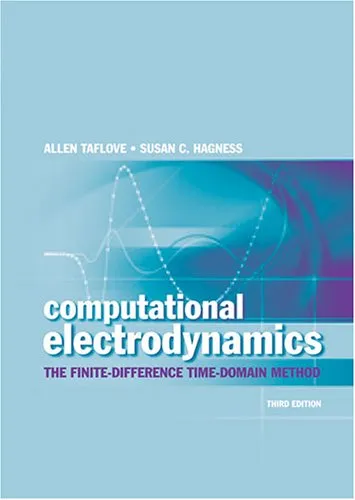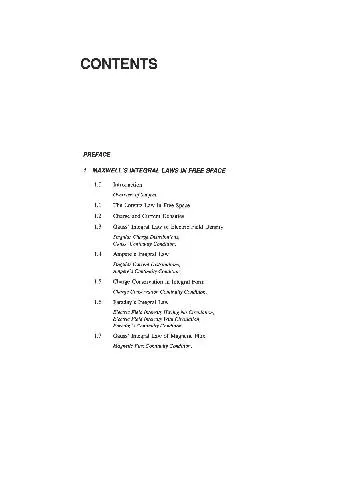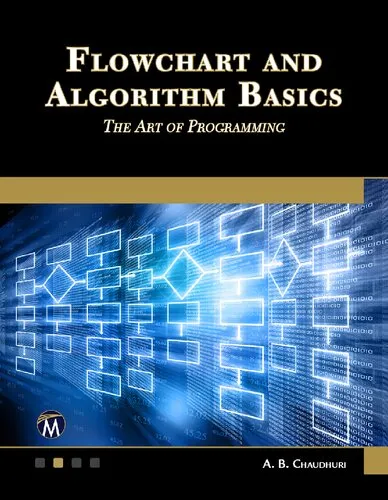Computational Electrodynamics: The Finite-Difference Time-Domain Method 2nd edition (Artech House Antennas and Propagation Library)
4.7
Reviews from our users

You Can Ask your questions from this book's AI after Login
Each download or ask from book AI costs 2 points. To earn more free points, please visit the Points Guide Page and complete some valuable actions.Related Refrences:
Introduction to Computational Electrodynamics: The Finite-Difference Time-Domain Method (2nd Edition)
This second edition of Computational Electrodynamics: The Finite-Difference Time-Domain Method offers a comprehensive and updated exploration of one of the most widely used methods in computational electrodynamics: the Finite-Difference Time-Domain Method (FDTD). Authored by Allen Taflove and Susan C. Hagness, this book is regarded as a cornerstone in the development of FDTD techniques, providing theoretical underpinnings and practical computations for engineers, researchers, and students working in the fields of electromagnetics, photonics, antenna design, and more.
The book builds upon the solid foundation laid out in its first edition, expanding the scope to include groundbreaking advancements in both the theory and practical implementation of the FDTD method. Simultaneously rigorous and accessible, this text allows readers to bridge the gap between foundational theory and modern computational challenges, offering insights into real-world applications that illuminate the power and flexibility of this numerical simulation approach.
Detailed Summary of the Book
The book is structured to guide the reader through the complete landscape of computational electrodynamics using the FDTD method. It begins with the basics of Maxwell’s equations, setting the stage with a thorough mathematical background suitable for readers of all technical levels. Significant emphasis is placed on understanding the leap from continuous equations to discrete numerical approximations, a core tenet of FDTD.
The authors then transition into the detailed implementation of the FDTD method. This includes derivations of finite-difference equations, time-stepping algorithms, and practical considerations for accurate simulations. The text explores boundary conditions like perfectly matched layers (PML) to terminate computational domains and reduce reflection artifacts.
Special topics include advanced FDTD techniques for handling nonlinear materials, subgridding, and multi-scale problems. Applications of the FDTD method are showcased through the design of antennas, microstrip circuits, optical waveguides, and interactions of light with nanostructures. The material is accompanied by explanatory figures, illustrative examples, and pseudo-code, ensuring the clarity and usability of the presented methods.
In this edition, new chapters and sections have been added, including material on dispersive media, higher-order time-domain techniques, and advances in computational resources, such as parallel processing and GPU acceleration. These updates keep the book relevant in contemporary settings where computational speed and accuracy are paramount. In addition, the second edition delves deeply into topics like photonic crystal simulation and biomedical applications, underscoring the universal applicability of FDTD in various electromagnetic domains.
Key Takeaways
- A comprehensive understanding of Maxwell’s equations and their relevance to computational electrodynamics.
- Step-by-step tutorials on implementing FDTD methods, complete with pseudo-code for practical implementation.
- Insights into advanced computational techniques, such as perfectly matched layers (PML) and sub-cell methods.
- Real-world applications ranging from antenna design to light-matter interactions for nanostructures.
- New sections dedicated to modern challenges, including GPU acceleration and biomedical applications.
Famous Quotes from the Book
"The Finite-Difference Time-Domain (FDTD) method is, at its core, an intuitive exploration of the solutions to Maxwell’s equations—a revealing lens through which we can understand how electromagnetic waves behave in complex environments."
"Through accurate numerical approximations, we transform the abstraction of electromagnetic physics into tangible, actionable designs."
"The true power of FDTD lies in its simplicity and universality, enabling us to tackle problems ranging from the terahertz scale of photonics to the biomedical scale of human tissue."
Why This Book Matters
The impact of Computational Electrodynamics cannot be overstated. This book has redefined how engineers and researchers solve electromagnetic problems, democratizing highly advanced tools like the FDTD method through clear explanations, robust derivations, and practical guidance. By addressing the challenges encountered in applying Maxwell’s equations to real-world problems, the authors empower readers to think creatively and solve complex issues with confidence.
Moreover, the second edition acknowledges the rapid progression of technology, incorporating the latest advancements to ensure relevance in modern research and industries. The ability to accurately simulate electromagnetic phenomena is central to developing cutting-edge technologies in communications, defense, optics, and more. Thus, this book serves as an essential reference for anyone contributing to innovation in these fields.
Whether you are a seasoned professional or a student entering the field, this book offers value at every level, from a strong foundational understanding of FDTD to its application in sophisticated research. It is a definitive text for computational electrodynamics, designed to educate, challenge, and inspire.
Free Direct Download
You Can Download this book after Login
Accessing books through legal platforms and public libraries not only supports the rights of authors and publishers but also contributes to the sustainability of reading culture. Before downloading, please take a moment to consider these options.
Find this book on other platforms:
WorldCat helps you find books in libraries worldwide.
See ratings, reviews, and discussions on Goodreads.
Find and buy rare or used books on AbeBooks.
1312
بازدید4.7
امتیاز0
نظر98%
رضایتReviews:
4.7
Based on 0 users review
Questions & Answers
Ask questions about this book or help others by answering
No questions yet. Be the first to ask!







![The Ultimate iOS Interview Playbook: Conquer Swift, frameworks, design patterns, and app architecture [Team-IRA]](https://s3.refhub.ir/images/thumb/The_Ultimate_iOS_Interview_Playbook__Conquer__29925.webp)







